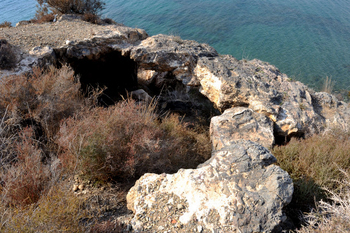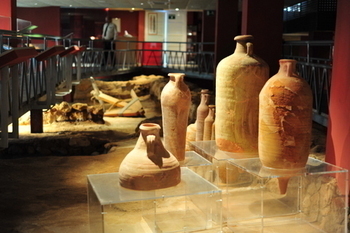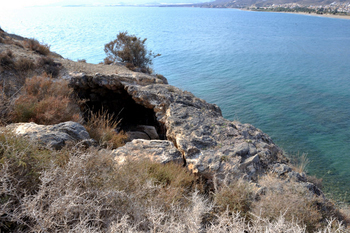Contact Águilas Tourist Office on +34 968 493 285
Send an Email
Click Here


At first sight there is nothing out of the ordinary about this 26-metre-high rocky outcrop to the south-west of Puerto de Mazarrón, joined to the mainland by a thin strip of land which divides the two bays of Playa Grande and Playa de Nares, but in fact it is home to a surprisingly significant archaeological site.
The whole outcrop is littered with shards of broken ceramics, important evidence of its use and occupation from the time of the Phoenicians, who are known to have traded actively along this coastline in the 7th century BC and left behind two sunken boats just a few hundred metres along the coast at Playa de la Isla (see following the Phoenicians in Murcia). Later the area was inhabited by the Iberians from around 550 BC to the 1st century BC, the Carthaginians, the Romans after 209 BC and of course the Moors, who were not expelled from Murcia until the 13th century.
 Although there are pieces of pottery all over the ground from all of these cultures they are not associated with any tangible archaeological structure, which makes it difficult to interpret them and the part they played in the history of the outcrop. However, they do show that these cultures were here at some point in history.
Although there are pieces of pottery all over the ground from all of these cultures they are not associated with any tangible archaeological structure, which makes it difficult to interpret them and the part they played in the history of the outcrop. However, they do show that these cultures were here at some point in history.
The Phoenicians may have been the first to use the hill, its height providing a strategic view over not only the surrounding seas but also the mainland, stretching out across modern day Mazarrón and the port. The presence of broken ceramics suggests that the hill may have been home to a small settlement where ships might have anchored in order to unload cargos: this was probably related to the settlement discovered at the other end of the next bay, at the site of Punta de Gavilanes.

However, most of the ceramics date from the time of Romans, who ruled over this part of Spain until the end of the second century AD. For them, the Cabezo del Castellar was a fish salting factory, as has been confirmed by the extensive archaeological digs of the 1980s and the underwater studies carried out by the national underwater archaeology museum of Cartagena.
Salted fish was one of the most popular foods in Roman times, and the strong taste was used to spice up many dishes (probably to disguise the state of preservation of some of the food used in preparing meals). Demand was so great that there were factories all along the coastline of Murcia and Andalucía, some very small and others extremely large, to satisfy the requirements of the whole of the Empire. Although it was the Romans who industrialised the process, the Carthaginians had already encouraged production in the 3rd century BC with a view to large-scale commerce.
 Certain types of ceramic product are closely related to the production of salted fish, such as the spatheia. These were specially produced amphorae, closed with cork, mortar or volcanic rock, and it was in them that the salted fish was sold.
Certain types of ceramic product are closely related to the production of salted fish, such as the spatheia. These were specially produced amphorae, closed with cork, mortar or volcanic rock, and it was in them that the salted fish was sold.
Most of the items found at the Cabezo del Castellar are spatheia, although there are also pieces of crockery from Africa, kitchen ceramics and other types of amphora, most of which were also used to store salted fish.
The best-known Roman salted fish product was garum sauce, which was produced extensively in Mazarrón and which was exported throughout the vast Empire. The remains of a large Roman salt fish factory were discovered during residential construction in Mazarrón, and today have been converted into a museum dedicated to the history of garum production. In addition, salting tanks are clearly visible at the site of the El Alamillo Roman Villa next to the beach of El Alamillo.

Physical remains on the Cabezo del Castellar
Although it's very difficult to actually see them, there are a number of remains on the Cabezo del Castellar.
From Roman times there are fortifications, ovens, rooms, salted fish tanks (two are visible, although only one has been excavated), two rooms, two water tanks, a stairway and what seems to be a small road along which carts would have reached the jetty.
 The two rooms are on the north of the hill, facing the mainland, and in the north-west is what seems to be a retaining wall for terracing the land, made from stone and mortar and about 60 cm in width. On the western side are the two salted fish tanks, while on the eastern slopes is a small sink or basin measuring 200cm x 80cm x 20cm. South of this are the ceramic ovens related to the amphorae, and next to them are the water tanks and the stairway, which may have been covered.
The two rooms are on the north of the hill, facing the mainland, and in the north-west is what seems to be a retaining wall for terracing the land, made from stone and mortar and about 60 cm in width. On the western side are the two salted fish tanks, while on the eastern slopes is a small sink or basin measuring 200cm x 80cm x 20cm. South of this are the ceramic ovens related to the amphorae, and next to them are the water tanks and the stairway, which may have been covered.
At the southern end of the thin strip of land connecting the hill to the mainland are the remains of the wall, fortifications and a tower, as well as what appears to be a mooring area and possibly the track for carts.
Note: there is no track leading onto the outcrop, so wear strong and practical shoes and take care when exploring and trying to locate remains, as some of the rock faces are sheer and dangerous.
For more local visiting information, news and events go to the home page of Mazarrón Today.